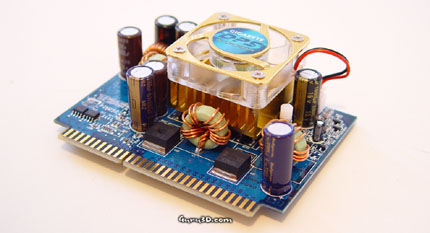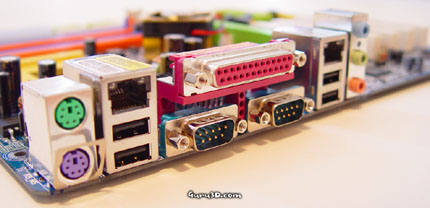Page 3 - Technology
Before we move on there are a few things you need to be aware of some differences compared to other nForce mainboards. First thing that comes to mind is a fourth DIMM memory slot. Normally you'd see three. This means you can use 2x2 dual channel memory configurations. All I can say is Finally ! Secondly, please make note of the fact that there are actually two additional controllers onboard, one for Serial ATA and one for Raid. That and the standard IDE controller makes this mainboard good for 10 devices ! That's a lot of storage people :)
The third item that brings a smile to your face is the Gigabyte DPS or Dual Power System. This nifty add-on is the best marketing I've ever seen. The Dual Power System is a small card you insert just above the CPU. It's connected to your PSU's 4 pin connector (the one that Pentium 4 mainboards use). Once connected it'll give the mainboard a 6-phase power circuitry instead of 3-phase. Gigabyte states that this will bring better stability onto your system, especially when you overclock it. We did some small tests and overclocking wise it made no difference for us.

Gigabyte Dual power System (6-phase DPS)
The fourth remarkable integration is the fact that the mainboard is equipped with no less than two Ethernet controllers, one 1000Mbit/sec and one 100 MBit/sec NIC. Gigabyte took Intels PRO/1000 MT adapter through the 82540EM controller for Gigabit Ethernet referred to by Intel as their Desktop version of the PRO/1000 MT. It is capable of 10/100/1000 Mbps which is a totally awesome options/integration. It's really good, not the best though as Intels PRO/1000CT Gigabit solution which is mostly integrated on the latest 865PE and 875P motherboards run through Intels new Gigabit bus, with a dedicated bandwidth of 266MB/s instead of sharing the 133 MB/s PCI bus with other devices. Still, I'm not complaining here.
I/O wise the 7NNXP has two PS/2 ports, two serial ports, one parallel port, four USB 2.0 ports, the two LAN ports (one 10/100 and one 10/100/1000), and Mic In, Line In, and Line Out ports, for the onboard sound. The IEEE 1394 FireWire support via a Realtek RTL8801 controller (can only be connected with the help of onboard headers, unfortunately not through the rear panel).
The NVIDIA MCP-T South Bridge has the nForce2 APU (Audio Processing Unit) integrated. This APU has support for hardware acceleration of 256 2D voices and 64 3D voices, it of course can also manage 3D positional audio. Secondly there is full support of Microsofts DX8.0 standard. And last but not least is it's support for Dolby Digital 5.1 and hardware Dolby Digital encoding (through SPDIF).
One of the nicest features the 7NNXP has onboard is IDE RAID from ITE, (GigaRAID IT8212F controller). There are two onboard IDE connectors which are capable of handling RAID 0 (striping), RAID 1 (mirroring) and RAID 0 + 1 RAID arrays. The best thing yet is that is not only can support four HDDs, but it in fact can support four ATAPI (optical) drives. See, the difference with a Promise or Silicon Image controller here is that it can handle more then just HD's. Next to the RAID configuration we can find a Serial ATA RAID controller from Silicon Image. This controller supports RAID 0, 1 and 0 + 1 arrays.
The 7NNXP also includes dual BIOS technology. If you crash, flunk or do something very stupid to your BIOS the second one can take over and will allow you to flash that BIOS back into the broken one. It will save the manufacturer quite a few RMA's and the end user a lot of trouble.
Every mainboard should have this at standard, that still is not the case though. For many this rule applies: Dual bios is not 100% needed and comes to the expense of the consumer since they are paying for it., it raises the mainboards price.
I do not agree, a motherboards worst nightmare is it's BIOS. I have red somewhere once that more then 60% of motherboard returned simply have a BIOS problem. If you short out for whatever reason the chance is high that the Bios on that motherboard is the buffer section to which all power will be diverted. The Dual Bios technology prevents the need for sending back your highly needed motherboard. And hey ... in the future when you flash your bios, you won't have to cross your thumbs anymore, you know that you are safe with the 2nd BIOS installed.

